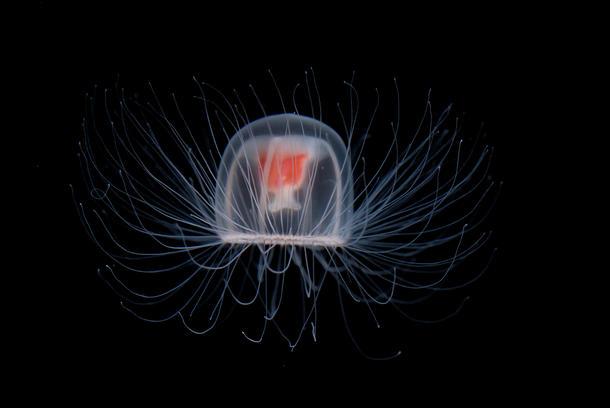Preface
In the beginning of Homo Deus, Yuval Noah Harari (YNH) conjectures that the next big frontier for humanity and science is immortality. After defeating plague, war, and famine, humans, whether we admit it or not, aspire to conquer death. To be more precise, we desire to conquer aging — we could always die in a freak car accident or something. According to YNH, humans wish to be “amortal” (the technical term for it is “biological immortality”, but those are a lot of syllables; like YNH, we’ll stick with “amortality” in this post).
Having heard about this idea from multiple sources recently (listed at the bottom), I decided to put together this post. Outline:
- First, I will describe a couple of creatures found in nature today that can seemingly live forever — they are really cool!
- Then I shall contemplate whether we really wish to be amortal like them (spoiler: nope, I don’t think so).
Hydra
 |
|---|
| Frank Fox / WikiMedia |
You may remember this tiny creature from your high-school biology textbooks. It has a tubular structure with tentacles on one end to grab food and a sticky ‘foot’ on the other to hold on to some support. Most Hydra are only about 3cm in length. They go about their business in freshwater ponds or lakes. Most people would live their entire lives without ever encountering a Hydra in real life or in conversations.
But here’s why you might never forget a Hydra.
Hydra are apparently amortal. You can cut them in two, and both halves will regenerate into healthy Hydras. You can cut up a Hydra in any number of pieces, and you will have as many ‘new’ Hydra. Heck, you can use a chemical to dissolve the thing that holds all its cells together, and you’ll get back a hydra from that pile of cells. So in that sense, Hydra are amortal.
Not immortal, because they can still get eaten (and digested) by fish, as well as starve or freeze to death.
This is a good segue into a creature that does not even starve to death.
Turritopsis dohrnii (a kind of jellyfish)
Turritopsis dohrnii is a kind of transparent-ish jellyfish found in oceans.
 |
|---|
| © Takashi Murai / The New York Times Syndicate / Redux |
What makes this jellyfish special is that it can seemingly turn the clock back on its body. More specifically, a full-grown jellyfish can ‘revert’ back to a baby jellyfish — basically a blob of cells. From there, it can grow back to an adult jellyfish as usual! 🤯
Scientists have observed Turritopsis dohrnii reverting to an earlier stage of its lifecycle like this when under extreme duress — for instance, when starving or injured. Imagine a butterfly turning back into a cocoon and re-emerging as a butterfly. (you can check out the complete life cycle in this lovely article)
The first question that came to my mind when I heard about this on the Science Vs podcast: do their memories (and learnings, if any) remain, or are they all lost?
If yes, this would be crazy! Amortality in its truest form!
But if not, what really is the difference between this jellyfish turning into a blob of cells versus a creature whose last action before its death is to asexually create a new offspring (a blob of cells) while it itself dissolves. Neat behavior nonetheless, but I wouldn’t call the latter phenomena a product of amortality. Right?
This again is a good segue into a philosophical discussion about amortality.
Do we really want to be amortal?
Let’s say we achieve the goal of amortality. That is, we don’t age. So what are the things that can kill us? Car accidents; plane accidents; medical treatments gone wrong; adventure sports gone wrong; heck, slipping in the bathroom and hitting our head.
Imagine the level of paranoia you would live with. That if you make a mistake, you might just DIE while your family and friends outlive you by decades. Many amortal people might never venture out of their thoroughly cushioned homes, minimizing their chances of a fatal accident.
Others might feel such paranoia is preposterous and go about living their lives as usual — playing sports, riding bikes. They might accept that they could die at any point and that living hundreds of years in a cushioned cage is not worth living at all.
So what are we left with? Fitness levels of when we were in our 20s or 30s for potentially hundreds of years, with an epsilon probability of dying any day (on average).
How would such a society look like?
Well, lots of really ‘old’ people, for starters. But in their case, age is literally just a number! Our working assumption is that we have solved aging. This means all our cells regenerate without any accumulating faults. Which implies our physical and mental capabilities may not deteriorate. Slow reflexes or geriatric degeneration would be tales of fiction. Everyone can keep working as long as they are alive. If they want to, that is. We would have to strive to remain physically and mentally.
Would it be hard to maintain physical and mental fitness?
Well, if you work out regularly and eat well, in all likelihood, you will be physically fit, even if you have been around the sun 200 times. Mental fitness is much more complicated. Imagine your children growing up to your physical and mental age. Imagine your partner dying due to an accident. Would you want to continue living? Would it seem normal to replace a spouse when ‘till death do us apart’ starts losing some of its meaning? Would it seem normal to replace children like that?
Yeah… mental health is a tough cookie. It’s hard to imagine how such a life would affect people. I think many amortals might become ardent stoics.*
To sum up, I think an amortal human society would consist primarily of (a) highly paranoid people and (b) those who don’t really care much and lead perfunctory lives.
But let me know what you feel! Can you see some benefits that I haven’t considered? Do you think the benefits outweigh the detriments?
* brilliantly portrayed in A Man from Earth; I would highly recommend checking out this prodigious movie! (pun not intended :P)
References and Further Reading
- Podcast: The Reluctant Immortalist, Invisibilia
- Goes into the amortality of Hydra (and how this research affected the life of the scientist who first claimed their biological immortality)
- Podcast: Back From the Dead, Science Vs
- Goes into the amortality of Turritopsis dohrnii (and other things, including recreating the voice of an Egyptian mummy!)
- Article: The animals that can live forever, Australian Academy of Science
- Describes the amortality of both creatures I discussed in a lot more detail
-
Wiki: Biological Immortality, Wikipedia
- Book: Homo Deus, Yuval Noah Harari
- Discusses the philosophical implications of amortality
- Book: Sapiens, Yuval Noah Harari
- Introduces the concept of “amortality” to distinguish it from immortality
- Book: A Thousand Brains, Jeff Hawkins
- Discusses the popular sci-fi trope of “uploading one’s brain” and dismantles it in a way similar to how YNH dismantles the idea of amortality.
